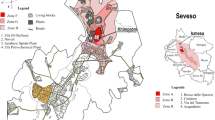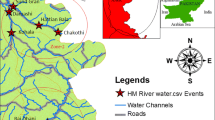Abstract
The Bien Hoa airbase (south of Vietnam) is known as one of the Agent Orange hotspots which have been seriously contaminated by Agent Orange/dioxin during the Vietnam War. Hundreds of samples including soil, sediment and fish were collected at the Bien Hoa Agent Orange hotspot for assessment of the environmental contamination caused by dibenzo-p-dioxins and polychlorinated dibenzofurans (PCDD/Fs). The toxicity equivalency quotient (TEQ) concentration of PCDD/Fs in soil and sediment varied from 7.6 to 962,000 and 17 to 4860 pg/g dry wt, respectively, implying very high contamination of PCDD/Fs in several areas. PCDD/F levels in fish ranged between 1.8 and 288 pg/g TEQ wet wt and was generally higher than advisory guidelines for food consumption. 2,3,7,8-Tetrachlorinated dibenzo-p-dioxins (2,3,7,8-TCDD) contributed 66–99 % of TEQ for most of the samples, suggesting 2,4,5-trichlorophenoxyacetic acid (2,4,5-T) from Agent Orange as the major source of the contamination. The vertical transport of PCDD/Fs was observed in soil column with high TEQ levels above 1000 pg/g dry wt (Vietnamese limit for necessary remediation activities- TCVN 8183:2009 (2009)) even at a depth of 1.8 m. The vertical transport of PCDD/Fs has probably mainly taken place during the “Ranch Hand” defoliant spray activities due to the leaks and spills of phenoxy herbicides and solvents. The congener patterns suggest that transports of PCDD/Fs by weathering processes have led to their redistribution in the low-land areas. Also, an estimate for the total volume of contaminated soil requiring remediation to meet Vietnamese regulatory limits is provided.





Similar content being viewed by others
References
Alvin L. Young (2009) The history, use, disposition and environmental fate of Agent Orange. Springer Publisher
Baker JI and Hites RA (2000) Is combustion the major source of Polychlorinated dibenzo-p-dioxins and Dibenzofurans to the environment? A mass balance investigation. Environ. Sci. Technol. 34:2879–2886
Bonn BA (1998) Polychlorinated dibenzo-p-dioxin and dibenzofuran concentration profiles in sediment and fish tissue of the Willamette basin. Oregon Environ Sci Technol 32:729–735
Castro-Jimenez J, Rotllant G, Abalos M, Parera J, Dachs J, Company JB, Calafat A, Abad E (2013) Accumulation of dioxins in deep-sea crustaceans, fish and sediments from a submarine canyon (NW Mediterranean). Prog Oceanogr 118:260–272
Colborn T, vom Saal FS, Soto AM (1993) Developmental effects of endocrine-disrupting chemicals in wildlife and humans. Environ Health Perspect 101:378–384
Consultants H (2009) Final report: comprehensive assessment of dioxin contamination in Da Nang airport environmental levels, human exposure and options for mitigating impacts. British Columbia, Canada, Viet Nam
Consultants H (2011) Final report: environmental and human health assessment of dioxin contamination at Bien Hoa airbase. British Columbia, Canada, Vietnam
Czuczwa JM and Hites RA (1986) Airborne dioxins and dibenzofurans: sources and fates. Environ. Sci. Technol. 20: 195–200
Dwernychuk WL (2005) Dioxin hot spots in Vietnam. Chemosphere 60:998–999
Dwernychuk LW, Cau HD, Hatfield CT, Boivin TG, Hung TM, Dung PT, Thai ND (2002) Dioxin reservoirs in southern Viet Nam—a legacy of Agent Orange. Chemosphere 47:117–137
European Commission (2011) COMMISSION REGULATION (EU) No 1259/2011 of 2 December 2011 amending Regulation (EC) No 1881/2006 as regards maximum levels for dioxins, dioxin-like PCBs and non dioxin-like PCBs in foodstuffs
Fernández J, Arjol MA, Cacho C (2013) POP-contaminated sites from HCH production in Sabiñánigo, Spain. Environ Sci Pollut Res Int 20(4):1937–1950
Fiedler H, Cao Z, Huang J, Wang B, Deng S, Yu G (2012) PCDD/PCDF Inventores 1990 VS. 2012. Organohalogen Compd 74:1521–1524
Götz R, Steiner B, Friesel P, Roch K, Walkow F, Maass V, Reincke H, Stachel B (1998) Dioxin (PCDD/F) in the river Elbe—investigations of their origin by multivariate statistical methods. Chemosphere 37(9–12):1987–2002
Götz R, Sokollek V, Weber R (2013) The dioxin/POPs legacy of pesticide production in Hamburg: part 2: waste deposits and remediation of Georgswerder landfill. Env Sci Pollut Res 20:1925–1936
Hue NTM, Nam VD, Thuong NV, Huyen NT, Phuong NTH, Hung NX, Tuan NH, Son LK, Minh NH (2014) Determination of PCDD/Fs in breast milk of women living in the vicinities of Da Nang Agent Orange hot spot (Vietnam) and estimation of the infant’s daily intake. Sci Total Environ 491–492:212–218
Karademir A, Ergül HA, Telli B, Kılavuz SA, Terzi M (2013) Evaluation of PCDD/F pollution in surface sediments of Izmit Bay. Environ Sci Pollut Res Int 20(9):6611–6619
Kishida M, Imamura K, Takenaka N, Maeda Y, Viet PH, Kondo A, Bandow H (2010) Characteristics of the abundance of polychlorinated dibenzo-p-dioxin and dibenzofurans, and dioxin-like polychlorinated biphenyls in sediment samples from selected Asian regions in Can Gio, southern Vietnam and Osaka, Japan. Chemosphere 78:127–133
Link B, Gabrio T, Zoellner I, Piechotowski I, Paepke O et al (2005) Biomonitoring of persistent organochlorine pesticides, PCDD/PCDFs and dioxin-like PCBs in blood of children from South West Germany (Baden-Wuerttemberg) from 1993 to 2003. Chemosphere 58:1185–1201
Lirong G, Zhang Q, Zhang B, Liu W, Xiao K (2014) Polychlorinated dibenzo-p-dioxins and dibenzofurans in water and six fish species from Dongting Lake, China. Chemosphere 114:150–157
Loonen H, Parsons JR, Govers HAJ (1994) Effect of sediment on the bioaccumulation of a complex mixture of polychlorinated dibenzo-pdioxins (PCDDs) and polychlorinated dibenzofurans (PCDFs) by fish. Chemosphere 28: 1433–1446
Mackay D, Shiu WY and Ma KC (2001) Illustrated Handbook of Physical-Chemical Properties and Environmental Fate for Organic Chemicals, Vol. II, Polynuclear Aromatic Hydrocarbons, Polychlorinated Dioxins and Dibenzofurans. 2001. Lewis, Boca Raton, FL, Chapter 3–4
Minh NH, Boivin T, Canh PN, Son LK (2009) Comprehensive assessment of dioxin contamination in Da Nang airbase and its vicinities: environmental levels, human exposure and options for mitigating impacts. In: Eds., Y. Obayashi, T. Isobe, A. Subramanian, S. Suzuki and S. Tanabe editors. Interdisciplinary studies on environmental chemistry—Environmental Research in Asia
Parera J, Abalos M, Santos FJ, Galceran MT, Abad E (2013) Polychlorinated dibenzo-p-dioxins, dibenzofurans, biphenyls, paraffins and polybrominated diphenyl ethers in marine fish species from Ebro River Delta (Spain). Chemosphere 93:499–505
Sakurai T, Suzuki N, Masunaga S, Nakanishi J (1998) Origin attribution of polychlorinated dibenzo-p-dioxins and dibenzofurans in sediment and soil from a Japanese freshwater lake area through congener-specific data analysis. Chemosphere 37(9–12):2211–2224
Schecter A, Ryan JJ, Papke O (1998) Decrease in levels and body burden of dioxin, dibenzofurans, PCBs DDE, and HCB in blood and milk in a mother nursing twins over a thirty eight month period. Chemosphere 37(9–12):1807–1816
Senthil Kumar K, Kannan K, Paramasivan ON, Shanmugasundaram VP, Nakanishi J, Masunaga S (2001) Polychlorinated dibenzo-p-dioxins, dibenzofurans, and polychlorinated biphenyls in human tissues, meat, fish and wildlife samples from India. Environ Sci Technol 35:3448–3455
Stachel B, Christoph EH, Gotz R, Herrmann T, Krugere F, Kuhn T, Layf J, Lofflerg J, Paepke O, Reincke H, Schroter-Kermani C, Schwartz R, Steeg E, Stehr D, Uhlig S, Umlauf G (2007) Dioxins and dioxin-like PCBs in different fish from the river Elbe and its tributaries, Germany. J Hazard Mater 148:199–209
Stellman JM, Stellman SD, Christian R, Weber T, Tomasallo C (2003) The extent and patterns of usage of Agent Orange and other herbicides in Vietnam. Nature 422:681–687
TCVN 8183:2009 (2009) Dioxin threshold in the soil and sediment. Vietnam ministry of Science and Technology. Hanoi, Vietnam
US EPA (1994) Method 1613B—tetra- through octa-chlorinated dioxins and furans by isotope dilution HRGC/HRMS
US EPA (2000) Exposure and human health reassessment of 2,3,7,8-tetrachlorodibenzo-p-dioxin (TCDD) and related compounds: part II: health assessment for 2,3,7,8-tetrachlorodibenzo-p-dioxin (TCDD) and related compounds. (EPA/600/P-00/001Be), US EPA
Vijgen J, Abhilash PC, Li Y-F, Lal R, Forter M, Torres J, Singh N, Yunus M, Tian C, Schäffer A, Weber R (2011) HCH as new Stockholm convention POPs—a global perspective on the management of Lindane and its waste isomers. Env Sci Pollut Res 18:152–162
Weber R, Varbelow G (2013) The dioxin/POPs legacy of pesticide production in Hamburg: part 1 securing of the production area. Env Sci Pollut Res 20:1918–1924
Weber R, Gaus C, Tysklind M, Johnston P, Forter M, Hollert H, Heinisch H, Holoubek I, Lloyd-Smith M, Masunaga S, Moccarelli P, Santillo D, Seike N, Symons R, Torres JPM, Verta M, Varbelow G, Vijgen J, Watson A, Costner P, Wölz J, Wycisk P, Zennegg M (2008) Dioxin- and POP-contaminated sites—contemporary and future relevance and challenges. Env Sci Pollut Res 15:363–393
Wu ZW, Schramm KW, Xu Y, Kettrup A (2001) Mobility and profiles of polychlorinated dibenzo-p-dioxins and dibenzofurans in sediment of Ya-Er Lake. China Wat Res 35:3025–3033
Wycisk P, Stollberg R, Neumann C, Gossel W, Weiss H, Weber R (2013) Integrated methodology for assessing the HCH groundwater pollution at the multi-source contaminated mega-site Bitterfeld/Wolfen. Env Sci Pollut Res 20:1907–1917
Zhang S, Ping P, Huang W, Li X, Zhang G (2009) PCDD/PCDF pollution in soils and sediments from the Pearl River Delta of China. Chemosphere 75:1186–1195
Zheng W, Yu H, Wang X, Qu W (2012) Systematic review of pentachlorophenol occurrence in the environment and in humans in China: not a negligible health risk due to the re-emergence of schistosomiasis. Environ Int 42:105–116
Acknowledgments
This study was jointly implemented under the frameworks of the project “Establishment of Dioxin Laboratory in Vietnam” (AP-16657 and BMGF-50799), the Research Grant KHCN-33.01/11-15 from the Vietnam National Science and Technology Research Program KHCN-33/11-15 (Research and overcoming long-term consequences of Agent Orange/Dioxin on the environment and the human health in Vietnam). The authors would like to express sincerest thanks to Dr. Roland Weber (POPs Environmental Consulting, Germany) for critical reading and comments to the manuscript.
Author information
Authors and Affiliations
Corresponding author
Additional information
Responsible editor: Roland Kallenborn
This article belongs to the series “Dioxin and POP Contaminated Sites” (Weber et al. 2008) edited by Roland Weber, Mats Tysklind and Caroline Gaus.
Rights and permissions
About this article
Cite this article
Van Thuong, N., Hung, N.X., Mo, N.T. et al. Transport and bioaccumulation of polychlorinated dibenzo-p-dioxins and dibenzofurans at the Bien Hoa Agent Orange hotspot in Vietnam. Environ Sci Pollut Res 22, 14431–14441 (2015). https://doi.org/10.1007/s11356-014-3946-9
Received:
Accepted:
Published:
Issue Date:
DOI: https://doi.org/10.1007/s11356-014-3946-9




